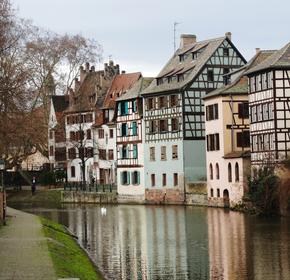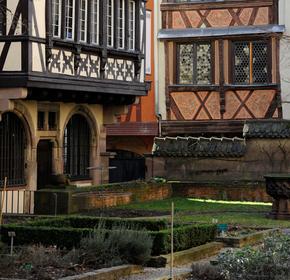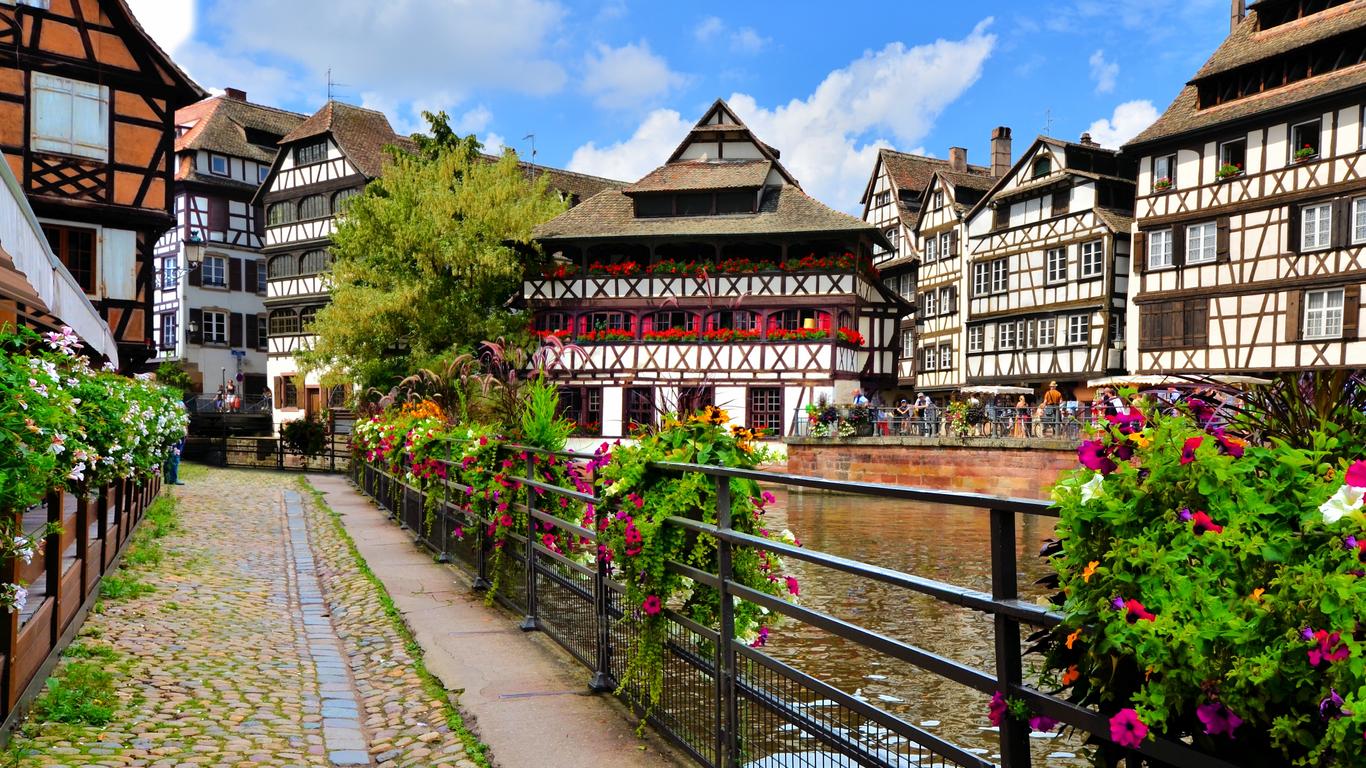
Strasbourg travel guide
Strasbourg Tourism | Strasbourg Guide
You're Going to Love Strasbourg
The capital of France's Alsace region, Strasbourg feels more European than almost any other city (perhaps because it has been fought over so much). Cosmopolitan, elegant and historic, it's simply magnificent.
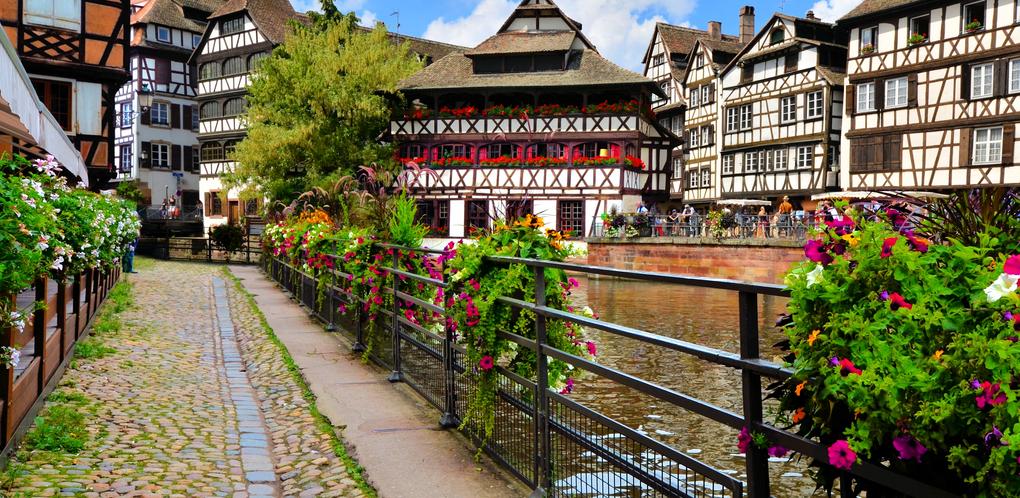
Top 5 Reasons to Visit Strasbourg
1. A UNESCO-Protected City Center
Strasbourg's medieval core has been awarded UNESCO heritage status. The Gothic cathedral, the timber-framed buildings and alleyways of the Petite France neighborhood and several churches add up to a magical neighborhood.
2. Superb Museums
From the Musée Historique that details Strasbourg's past to the trio of exceptional museums in the Palais Rohan, Strasbourg is ideal for museum fans.
3. Welcoming Traditional Taverns
Nothing could be better after a long day of sightseeing than retiring to one of Strasbourg's many cosy winstubs for Alsatian beer and fine cuisine.
4. Endless Cultural Events
With the lavish shows at the Opera, classical concerts at the Conservatory and quirkier events like the Marionnette festival, there's always something to satisfy culture lovers in Strasbourg.
5. Fantastic Open Air Markets
Shopping is a real highlight in Strasbourg, whether you head to the enchanting festive Christkindelsmärik market or to the regular food and apparel markets on the Place Broglie.
What to do in Strasbourg
1. Cathédrale Notre-Dame de Strasbourg: Romanesque Meets Gothic
The Cathedral of Our Lady of Strasbourg or Cathédrale Notre-Dame de Strasbourg, a Roman Catholic church, is a renowned example of Romanesque and Gothic architecture. The structure stands at 466 feet high and was the tallest building in the world from 1647 to 1874. The cathedral was built from sandstone extracted from the Vosges Mountains, which gives the building a pleasant pink hue. The church features 12th- to 14th-century stained glass, a baptismal font designed by Jost Dotzinger in 1443, a pulpit created by Hans Hammer in 1486, life-sized sculptures depicting Christ on the Mount of Olives, and the Life of Mary tapestries designed in the seventeenth century.
2. Petite-France: Explore the Canals
Petite France, a historic quarter of Strasbourg in the center of the city, is a UNESCO World Heritage Site. The area is divided into several channels by the River Ill. Upstream, visitors will find Barrage Vauban, a 17th-century fortress. The Ponts Couverts, an 18th-century fortification with three bridges and four towers, lies downstream. In the center of the quarter, the Pont du Faisan, a swing bridge, is used by passenger boats. The Maison des Tanneurs, on the north bank, is home to the Tanner's Guild and Place Benjamin-Zix, which leads to the Rue des Dentelles, the Rue du Bain-aux-Plantes, and the Saint-Thomas church.
3. Église Saint-Thomas: Monument to History
The Église Saint-Thomas, five-naved hall church, began construction in 1196. The interior features a late-Gothic cupola, a gallery to the left, and chapels at both sides of the apse. The main Lutheran church in Strasbourg, it is the only hall church in Alsace. Located on the Route Romane d'Alsace, the building has been classified as a historical monument by the French Ministry of Culture since 1862. Highlights include A 1741 Silbermann organ played by Mozart in 1778, the sarcophagus of Bishop Adelochus - which dates back to 1130, the mausoleum of Marshall Maurice de Saxe, and the tombstone of Nikolaus Roeder von Tiersberg from 1510.
4. Parlement Européen: Modern Day Amphitheater
The Parlement Européen consists of five buildings, located in the Quartier Européen of Strasbourg. The main structure, the Louise Weiss building, which houses the hemicycle for plenary sessions, was dedicated in 1999 at the intersection of the Ill and the Marne-Rhine Canal. The building, inspired by the Roman amphitheaters, features a 200-foot tower. The secondary structures include the Winston Churchill building in the Orangerie district, the Salvador de Madariaga building on the Quai du Bassin, the heart-shaped Pierre Pflimlin building, and the Václav Havel building, which was originally opened in 1954 and reconstructed by the Parliament in 2012.
5. Musée de l’Œuvre Notre-Dame: Art of the Rhine
The Musée de l'Œuvre Notre-Dame features decorative and fine arts from the Upper Rhine that date from the Middle Ages to 1681. Renowned for its original sculptures, stained glass windows, and architectural fragments of the Strasbourg Cathedral, the museum contains such esteemed masterpieces as the Ecclesia and Synagoga statues from Notre-Dame de Strasbourg, a self-portrait by Nikolaus Gerhaert, the Holy Monk sculpture by Hans Wydyz, and the Saints Catherine and Mary Magdalene painting by Konrad Witz.
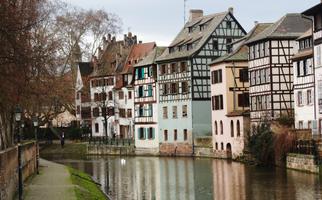

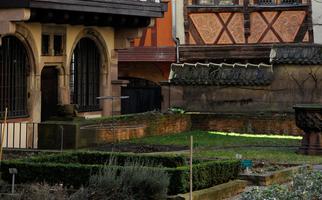

1. Cathédrale Notre-Dame de Strasbourg: Romanesque Meets Gothic
The Cathedral of Our Lady of Strasbourg or Cathédrale Notre-Dame de Strasbourg, a Roman Catholic church, is a renowned example of Romanesque and Gothic architecture. The structure stands at 466 feet high and was the tallest building in the world from 1647 to 1874. The cathedral was built from sandstone extracted from the Vosges Mountains, which gives the building a pleasant pink hue. The church features 12th- to 14th-century stained glass, a baptismal font designed by Jost Dotzinger in 1443, a pulpit created by Hans Hammer in 1486, life-sized sculptures depicting Christ on the Mount of Olives, and the Life of Mary tapestries designed in the seventeenth century.
2. Petite-France: Explore the Canals
Petite France, a historic quarter of Strasbourg in the center of the city, is a UNESCO World Heritage Site. The area is divided into several channels by the River Ill. Upstream, visitors will find Barrage Vauban, a 17th-century fortress. The Ponts Couverts, an 18th-century fortification with three bridges and four towers, lies downstream. In the center of the quarter, the Pont du Faisan, a swing bridge, is used by passenger boats. The Maison des Tanneurs, on the north bank, is home to the Tanner's Guild and Place Benjamin-Zix, which leads to the Rue des Dentelles, the Rue du Bain-aux-Plantes, and the Saint-Thomas church.
3. Église Saint-Thomas: Monument to History
The Église Saint-Thomas, five-naved hall church, began construction in 1196. The interior features a late-Gothic cupola, a gallery to the left, and chapels at both sides of the apse. The main Lutheran church in Strasbourg, it is the only hall church in Alsace. Located on the Route Romane d'Alsace, the building has been classified as a historical monument by the French Ministry of Culture since 1862. Highlights include A 1741 Silbermann organ played by Mozart in 1778, the sarcophagus of Bishop Adelochus - which dates back to 1130, the mausoleum of Marshall Maurice de Saxe, and the tombstone of Nikolaus Roeder von Tiersberg from 1510.
4. Parlement Européen: Modern Day Amphitheater
The Parlement Européen consists of five buildings, located in the Quartier Européen of Strasbourg. The main structure, the Louise Weiss building, which houses the hemicycle for plenary sessions, was dedicated in 1999 at the intersection of the Ill and the Marne-Rhine Canal. The building, inspired by the Roman amphitheaters, features a 200-foot tower. The secondary structures include the Winston Churchill building in the Orangerie district, the Salvador de Madariaga building on the Quai du Bassin, the heart-shaped Pierre Pflimlin building, and the Václav Havel building, which was originally opened in 1954 and reconstructed by the Parliament in 2012.
5. Musée de l’Œuvre Notre-Dame: Art of the Rhine
The Musée de l'Œuvre Notre-Dame features decorative and fine arts from the Upper Rhine that date from the Middle Ages to 1681. Renowned for its original sculptures, stained glass windows, and architectural fragments of the Strasbourg Cathedral, the museum contains such esteemed masterpieces as the Ecclesia and Synagoga statues from Notre-Dame de Strasbourg, a self-portrait by Nikolaus Gerhaert, the Holy Monk sculpture by Hans Wydyz, and the Saints Catherine and Mary Magdalene painting by Konrad Witz.




Where to Eat in Strasbourg
Great food is easy to find in Strasbourg. Local highlights are numerous, but some standout restaurants include Restaurant 1741, featuring Michelin-starred chef Guillaume Scheer, and Les Haras de Strasbourg, which has a stunning interior design. Meals should come to between EUR20-EUR40, depending on where you choose to dine.
When to visit Strasbourg
Strasbourg is appealing at almost any time of year. If you want to see the sights without huge crowds to contend with, visit from April to June or in October.
How to Get to Strasbourg
Plane
Strasbourg International Airport has regional connections to cities like Paris and London. A direct airport train runs into town and costs EUR4.30.
Train
Most major French destinations enjoy high-speed rail links to Strasbourg along with Swiss and German cities. The station is in western Strasbourg, a short taxi ride from the old center.
Car
From Paris, take the A4 straight to Strasbourg. The A5 runs from Frankurt and also north from the Swiss border.
Bus
Flixbus, Ouibus and Eurolines all run buses into the center of Strasbourg, connecting it to almost every regional city.
Airlines serving Strasbourg
Where to stay in Strasbourg
Petite France - An absolutely gorgeous part of the city center. Characterized by black-timber-framed buildings and narrow streets, Petite France is a joy to walk around.
Popular Neighborhoods in Strasbourg
Grande île - The historic center, Grande île is home to the stunning Gothic cathedral and most of the city's (many) museums.
Krutenau - More modern than the city center, Krutenau is a prosperous neighborhood that hosts great eateries like Restaurant 1741 and Gavroche.
Where to stay in popular areas of Strasbourg
Most booked hotels in Strasbourg
How to Get Around Strasbourg
Public Transportation
CTS runs an excellent bus and tram network around Strasbourg. Single tickets cost EUR1.70 and you can ride for 24 hours for just EUR4.30.
Taxi
Taxi rates vary depending on which company you choose but tend to be fairly reasonable. A typical inner city journey of a couple of miles won't cost more than EUR7.
Car
Car rental companies in Strasbourg include Europcar and Avis. Rates can be as low as EUR15 per day for smaller vehicles.
The Cost of Living in Strasbourg
Shopping Streets
Major malls inside the old city include Place des Halles and Rivetoile, while the streets of Petite France are lined with boutiques and gift stores. Be sure to check out open air markets on Grande île during your stay as well.
Groceries and Other
Local supermarkets include U Express, Carrefour and Monoprix. Prices should be reasonable at around EUR3.60 for a gallon of milk.
